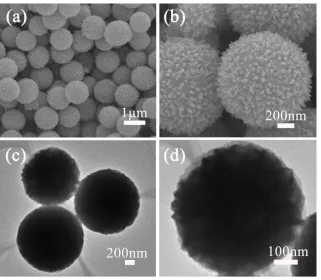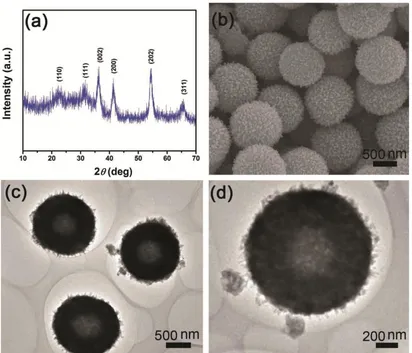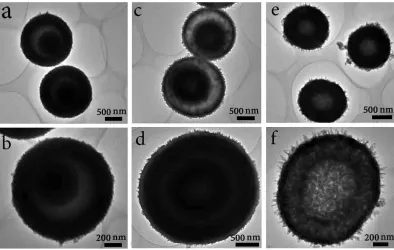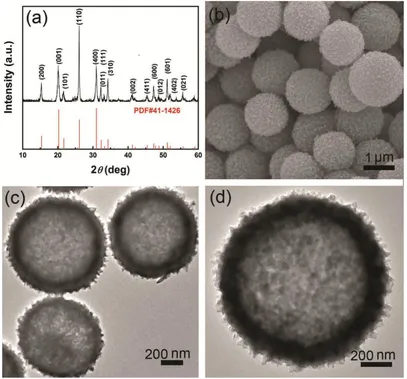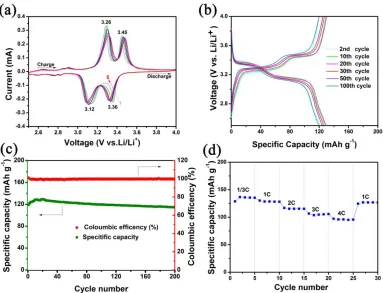Int. J. Electrochem. Sci., 12 (2017) 6885 – 6894, doi: 10.20964/2017.07.64
International Journal of
ELECTROCHEMICAL
SCIENCE
www.electrochemsci.org
Controllable Preparation of V
2O
5Hollow Microspheres as
Cathode Materials for Lithium-Ion Batteries
Xinxin An1,§, Qiong Su2,§,Yanglin Liu1, Anqiang Pan1,* 1
School of Materials Science and Engineering, Central South University, Changsha 410083, PR China. 2
Hunan Yingzi Biotechnology Incorporation, Changsha, 410083, Hunan, PR China
§the authors are contributed equally to this work *
E-mail: pananqiang@csu.edu.cn
Received: 13 April 2017 / Accepted: 11 May 2017 / Published: 12 June 2017
Hollow-structured vanadium oxides with tunable interiors have attracted significant attention in energy storage and conversion systems. In this work, we report the continuous structural engineering of VO2 solid microspheres utilizing a second solvothermal solution under the driving force of an Ostwald-ripening mechanism. The VO2 microspheres with diversified interior structures, such as yolk-shelled, double-shelled and complete hollow microspheres, were obtained by simply controlling the solvothermal duration in the new solvothermal solution. The obtained VO2 microspheres were converted into V2O5 microspheres with good structural preservation after calcination. As a cathode material for lithium batteries, the V2O5 hollow microspheres exhibited high capability and good cycling stability. A high specific discharge capacity of 129.4 mA h g−1 was obtained for the V2O5 hollow microsphere electrode, which retained 114.5 mA h g−1 after 200 cycles. The superior electrochemical properties were attributed to the promising features of the hollow microspheres.
Keywords: Vanadium oxide; hollow microspheres; solvothermal synthesis; lithium batteries
1. INTRODUCTION
Vanadium pentoxide (V2O5), a desirable alternative cathode material, has drawn much attention due to its low cost, abundant resources, high output voltage[11, 12] and high theoretical capacity (294 mA h g−1 for two lithium ions per formula)[13-16]. Nevertheless, the practical use of V2O5 has been held back due to the low ionic diffusivity of Li+ ions (10-13 to 10-12 cm2 S-1), moderate electrical conductivity (10-3 to 10-2 cm-1) and poor structural stability[5, 17-20]. Recently, porous- or hollow-structured V2O5 electrode materials have exhibited promising Li+ ion storage properties owing to their improved electrolyte penetration, easy accommodation of volumetric changes upon Li+ intercalation/deintercalation, and lower polarization[21]. Moreover, hollow microspheres can alleviate the aggregation of the electrode materials during repeated cycles. To date, various strategies, such as hard-templating methods[22], solvothermal treatments[23, 24] and self-templating approaches[25, 26], have been reported for the fabrication of hollow-structured V2O5 microspheres, which exhibit improved electrochemical performances. Pan et al. reported the preparation of VO2 microspheres with diversified interior structures by a time-dependent Ostwald-ripening process.[25] However, the entire process was studied in a single solvent. It would be interesting to study the structural evolution of the obtained VO2 microspheres in another solvothermal solvent, which would expand the feasibility of fabricating hollow-structured V2O5 microspheres with diversified interior structures.
In this paper, we report the controllable synthesis of VO2 hollow microspheres with yolk-shell, double-shell and single-shell interior structures by a second solvothermal process using the solvothermally prepared VO2 solid microspheres as starting materials. The VO2 microspheres are robust and can be readily converted into V2O5 hollow microspheres with good structural preservation by calcination in air. As cathode materials for LIBs, the obtained V2O5 hollow microspheres manifest high specific capacity and superior cycling stability.
2. EXPERIMENTAL
2.1 Preparation of materials
VO2 solid microspheres: All the chemicals and solvents were of analytical grade and used
without further purification. VO2 solid microspheres were solvothermally fabricated according to a previous report[25]. In a typical synthesis, V2O5 (1.2 g) and oxalic acid in a stoichiometric ratio of 1:3 were added into 40 mL of distilled water and magnetically stirred at 60 °C for several hours to get a clear, blue solution of VOC2O4. The obtained VOC2O4 solution (3 mL) and 30 mL isopropanol were added into a 50 mL PPL container and magnetically stirred at room temperature for 20 min. Then, the container was sealed in a stainless-steel autoclave and treated at 200 ℃ for 2 h. After cooling to room temperature naturally, the precipitates were collected by a centrifuge and washed with absolute alcohol three times. The VO2 solid microspheres were obtained by drying at 80 ℃ for 12 h.
h. The obtained samples were designated as VO2-12 h, VO2-24 h and VO2-36 h. After annealing at 350
℃ for 2 h with a heating rate of 1 ℃ min-1, the obtained solvothermal products were converted into V2O5 hollow microspheres.
2.2 Structural characterization
The crystalline structures of all the products were determined by X-ray diffraction (XRD, Rigaku D/max 2500 XRD with Cu Kα radiation, λ=1.54178 Å). The morphologies and structures of the synthesized products were determined by scanning electron microscopy (SEM, FEI Nova NanoSEM 230) and transmission electron microscopy (TEM, JEOL JEM-2100F).
2.3 Electrochemical measurements
The electrochemical properties of the V2O5 hollow microspheres were investigated in two-electrode coin-type cells (CR 2016). V2O5, acetylene black, and polyvinylidene fluoride (PVDF) binder in a weight ratio of 70:20:10 were mixed and then dispersed in an N-methyl-2-pyrrolidone (NMP) solution to make a slurry, which was coated on aluminum foil and dried in a vacuum oven at 100 °C overnight prior to coin cell assembly. The half-cells were assembled in a glove box (MBraun, Germany) filled with ultrahigh-purity argon. A polypropylene membrane was used as the separator, and 1 M LiPF6 dissolved in ethylene carbonate/dimethyl carbonate (EC/DMC) = 1:1 (volume ratio) was used as the electrolyte. Lithium metal was employed as the counter and reference electrodes. Cyclic voltammetry (CV; 2.5–4.0 V, 0.1 mV s-1) measurements were performed by a CHI 660C electrochemical workstation. The galvanostatic charge-discharge characteristics of the cells were obtained on a Land Battery Tester (Land CT 2001A, Wuhan, China) in the voltage range of 2.5-4.0 V(versus Li/Li+) at room temperature. The mass loading of the cathode material was approximately 1.5 mg cm-2, and the specific capacity was calculated based on the weight of the active material only.
3.RESULTS AND DISCUSSION
3.1 Morphology and structure
Scheme 1. Illustration of the formation of VO2 hollow microspheres in EG solvent with different solvothermal times: 12 h (I), 24 h (II), and 36 h (III).
[image:4.596.93.498.76.143.2]Fig. 1 shows the FESEM and TEM images of the pre-formed VO2 solid microspheresby the solvothermal method using isopropanol as the solvent. The FESEM image (Fig. 1a) demonstrates the solid VO2 microspheres have a mean diameter of 1 μm and possess a uniform spherical morphology. As shown in Fig. 1b, the surface of the VO2 solid microspheres consists of small nanoplates with thicknesses of approximately 20 nm. The TEM images (Fig. 1c and d) reveal the solid interior and the small plates on the surface of the VO2 microspheres.
Figure 1. FESEM images (a, b) and TEM images (c, d) of the VO2 microspheressynthesized at 200 °C after the solvothermal reaction for 2 h.
[image:4.596.140.461.342.622.2]
shows the FESEM image of the VO2-36 h solvothermal product, which has a uniform spherical morphology with a mean diameter of 1 μm. The TEM images (Fig. 2c and d) reveal the interior structure of the VO2 microspheres, displaying the hollow interiors and the porous structure of the exterior shell. The results demonstrate the possibility of adjusting the interior structures of the VO2 solid microspheres in different solvothermal solvents.
Figure 2. (a) XRD pattern, (b) FESEM image, and (c, d) TEM images of the VO2-36 h hollow microspheres prepared via the two-step solvothermal process.
[image:5.596.93.505.180.533.2]
complete hollow microspheres. These structural evolutions can be explained by the inside-out Ostwald-ripening process, which generates the exterior crystalline shell via a depletion of the inner material[27, 28]. However, the Ostwald-ripening process ultimately leads to a completely hollow structure with a single shell[29, 30]. The dissolution of VO2 at a specific area is attributed to its lower crystallinity and stability[31, 32]. When the solid microspheres are solvothermally treated sufficiently, the interior structures are dissolved to generate the completely hollow VO2 microspheres.
Figure 3. TEM images of the VO2 microspheres obtained at different times of the second step solvothermal process: (a, b) 12 h, (c, d) 24 h, and (e, f) 36 h.
[image:6.596.101.495.198.448.2]
Figure 4. (a) XRD pattern, (b) FESEM image and (c, d) TEM images of the V2O5 hollow microspheres.
3.2 Electrochemical performance
The as-prepared V2O5 hollow microspheres were assembled into coin cells to evaluate their electrochemical performances, and the results are shown in Fig. 5. Fig. 5a shows the initial five successive CV curves of the V2O5 hollow microspheres in the voltage range of 2.5-4 V vs. Li/Li+ at a scan rate of 0.1 mV s-1. The two main peaks at 3.36 and 3.12 V during the cathodic scan indicate a multi-step lithium-ion intercalation process and the phase changes from α-V2O5 to ɛ-Li0.5V2O5 (3.36 V) and then to δ-LiV2O5 (3.12 V)[34]. The two peaks at 3.26 and 3.45 V in the following anodic scan are attributed to the lithium deintercalation process and the phase changes from δ-LiV2O5 to ɛ-Li0.5V2O5 and then to α-V2O5, respectively[35]. The shapes of the five CV curves are similar, suggesting good reversibility and cycling stability. Fig. 5b depicts the discharge and charge profiles of the 2nd, 10th, 20th, 30th, 50th, and 100th cycles for the V2O5 hollow microspheres at a current density of 100 mA g -1
[image:7.596.95.502.69.448.2]
Figure 5. (a) CV curves of the V2O5 hollow microspheres at a scan rate of 0.1 mV s-1 in the voltage range between 2.5 V and 4 V vs. Li/Li+. (b) Galvanostatic discharge/charge profiles of selected cycles at a current density of 100 mA g-1. (c) Cycling performance and coulombic efficiency of the V2O5 hollow microspheres. (d) Rate performance of the V2O5 hollow microspheres.
[image:8.596.106.489.87.380.2]
cycles were reported. In addition, the other reported 3D hierarchical V2O5 flowers[37] also suffered from low capacity and rate capability. The superior rate performance reported here is attributed to the hollow structure of the microspheres. The hollow interiors of the microspheres can better accommodate volume changes upon repeated cycling, ensuring good structural integrity. Moreover, the contact area between the electrode and electrolyte can be enlarged, which can facilitate a good rate capability.
4. CONCLUSION
In summary, VO2 microspheres with different interior structures were prepared from solid microspheres utilizing an additional solvothermal solution under the driving mechanism of Ostwald ripening. The obtained VO2 microspheres were converted into V2O5 hollow microspheres with good structural preservation after annealing in air. As a cathode material for lithium-ion batteries, the hollow-structured V2O5 microspheres showed good cycling stability and rate capability. The preparation strategy may be applied for the synthesis of other materials.
ACKNOWLEDGEMENT
This work was supported by the National Natural Science Foundation of China (No. 51302323), the Program for New Century Excellent Talents in University (NCET-13-0594), Innovation-driven Project of Central South University (No.502501001) and the Research Fund for the Doctoral Program of Higher Education of China (No. 20130162120005).
References
1. Y.-Z. Zheng, H. Ding, E. Uchaker, X. Tao, J.-F. Chen, Q. Zhang, G. Cao, J. Mater. Chem. A, (2014) 1979.
2. Q. Yue, H. Jiang, Y. Hu, G. Jia, C. Li, Chem. Comm. 50 (2014) 13362.
3. M.L. Qin, J. Liu, S.Q. Liang, Q. Zhang, X.L. Li, Y. Liu, M.Y. Lin, J. Solid State Electrochem. 18 (2014) 2841.
4. J. Shao, X. Li, Z. Wan, L. Zhang, Y. Ding, L. Zhang, Q. Qu, H. Zheng, ACS Appl. Mate. Interfaces, (2013) 7671.
5. S. Wang, Z. Lu, D. Wang, C. Li, C. Chen, Y. Yin, J. Mater. Chem. 21 (2011) 6365.
6. X. Rui, J. Zhu, D. Sim, C. Xu, Y. Zeng, H.H. Hng, T.M. Lim, Q. Yan, Nanoscale, (2011) 4752. 7. S. Liang, X. Cao, Y. Wang, Y. Hu, A. Pan, G. Cao, Nano Energy, 22 (2016) 48.
8. M.S. Islam, C.A. Fisher, Chem. Soc. Rev. 43 (2014) 185.
9. Y.W. Lei Yao, J.H. Wu, M.W. Xiang, J.L. Li, B.Y. Wang, Y. Zhang, H.L. Hao Wu, Inter. J. Electrochem. Sci. 12 (2017) 206.
10. W. Lu, Int. J. Electrochem. Sci. (2017) 1118.
11. S. Liang, Y. Hu, Z. Nie, H. Huang, T. Chen, A. Pan, G. Cao, Nano Energy, 13 (2015) 58. 12. Y. Su, A. Pan, Y. Wang, J. Huang, Z. Nie, X. An, S. Liang, J. Power Sources, 295 (2015) 254. 13. S. Wang, S. Li, Y. Sun, X. Feng, C. Chen, Energy Environ Sci. 4 (2011) 2854.
14. X. Zhou, G. Wu, J. Wu, H. Yang, J. Wang, G. Gao, Phys. Chem. Chem. Phys. 16 (2014) 3973. 15. S.Q. Liang, M.L. Qin, Y. Tang, Q. Zhang, X.L. Li, X.P. Tan, A.Q. Pan, Met. Mater. Int. 20 (2014)
16. A.Q. Pan, H.B. Wu, L. Zhang, X.W. Lou, Energy Environ. Sci. 6 (2013) 1476. 17. Y.N. Ko, Y. Chan Kang, S.B. Park, Nanoscale, 5 (2013) 8899.
18. J. Cheng, B. Wang, H.L. Xin, G. Yang, H. Cai, F. Nie, H. Huang, J. Mater. Chem. A, 1 (2013) 10814.
19. Y. Wang, K. Takahashi, K.H. Lee, G.Z. Cao, Adv. Funct. Mater. 16 (2006) 1133.
20. Y. Zhang, A. Pan, Y. Wang, W. Wei, Y. Su, J. Hu, G. Cao, S. Liang, ACS Appl. Mater. Interfaces, 8 (2016) 17303.
21. H.E. Wang, D.S. Chen, Y. Cai, R.L. Zhang, J.M. Xu, Z. Deng, X.F. Zheng, Y. Li, I. Bello, B.L. Su, J. Colloid Interf. Sci. 418 (2014) 74.
22. H.B. Wu, A.Q. Pan, H.H. Hng, X.W. Lou, Adv. Funct. Mater. 23 (2013) 5669. 23. A. Pan, T. Zhu, H.B. Wu, X.W. Lou, Chem. Eur. J. 19 (2013) 494.
24. E. Uchaker, N. Zhou, Y. Li, G. Cao, J. Phys. Chem. C, 117 (2013) 1621. 25. A. Pan, H.B. Wu, L. Yu, X.W. Lou, Angew. Chem. Int. Ed. 52 (2013) 2226. 26. L. Zeng, A. Pan, S. Liang, J. Wang, G. Cao, Sci. China Mater. 59 (2016) 567. 27. X.W. Lou, L.A. Archer, Z. Yang, Adv. Mater. 20 (2008) 3987.
28. Y. Zhao, L. Jiang, Adv. Mater. 21 (2009) 3621.
29. X.B. Cao, L. Gu, L.J. Zhuge, W.J. Gao, W.C. Wang, S.F. Wu, Adv. Funct. Mater. 16 (2006) 896. 30. J.G. Yu, H. Guo, S.A. Davis, S. Mann, Adv. Funct. Mater. 16 (2006) 2035.
31. P.W. Voorhees, J. Stat. Phys. 38 (1985) 231.
32. H. G.Yang, H. C. Zeng, J. Phys. Chem. B, 108 (2004) 3492.
33. A.-M. Cao, J.-S. Hu, H.-P. Liang, L.-J. Wan, Angew. Chem. Int. Ed. 44 (2005) 4391.
34. Y.-S. Hu, X. Liu, J.-O. Müller, R. Schlögl, J. Maier, D.S. Su, Angew. Chem. Int. Ed. 121 (2009) 216. 35. A. Odani, V.G. Pol, S.V. Pol, M. Koltypin, A. Gedanken, D. Aurbach, Adv. Mater. 18 (2006) 1431. 36. H. Fei, W. Feng, Y. Lin, Solid State Sci. 55 (2016) 36.
37. H. Pang, Q. Song, P. Tian, J. Cheng, N. Zou, G. Ning, Mater. Lett. 171 (2016) 5.
